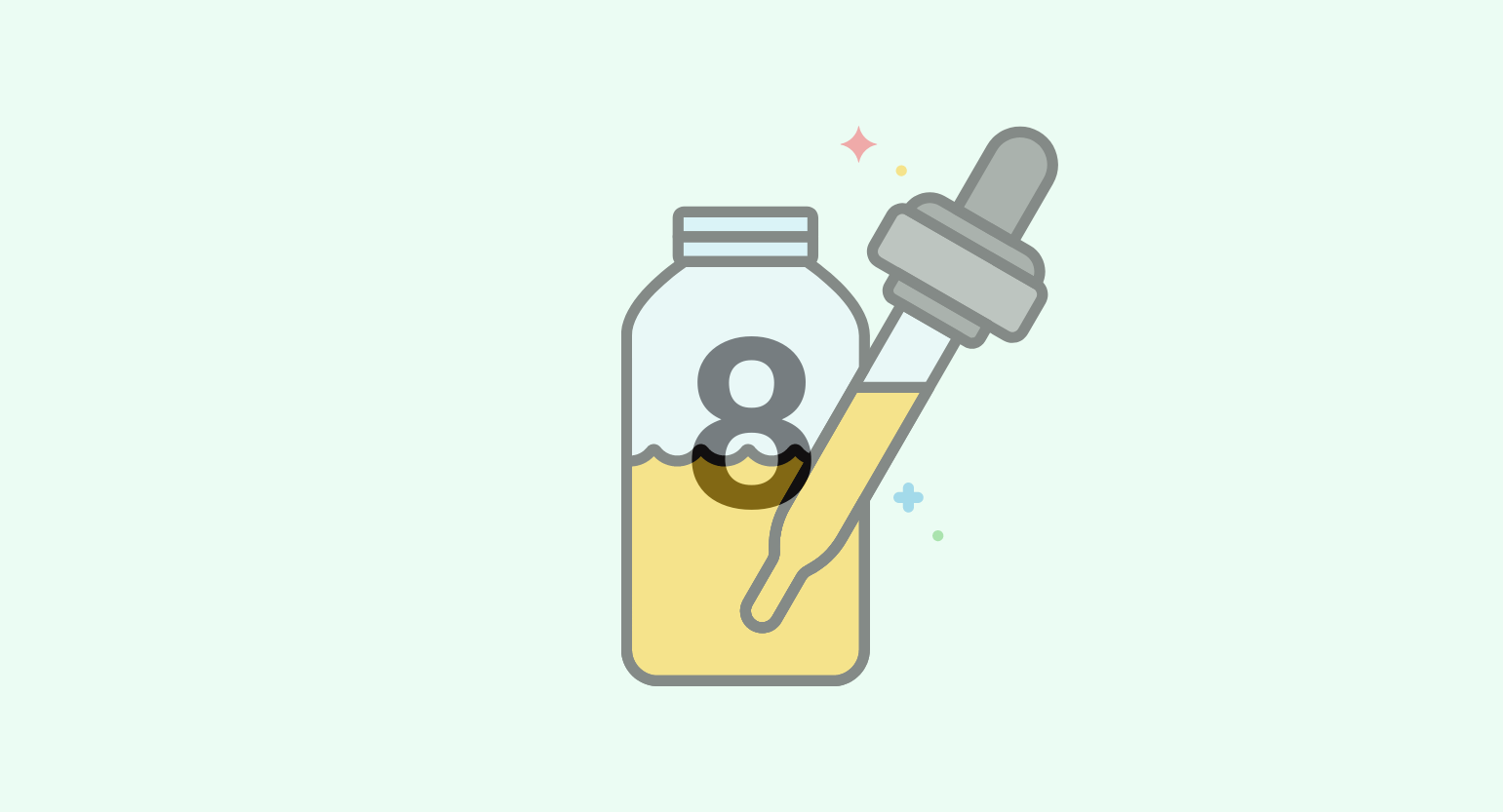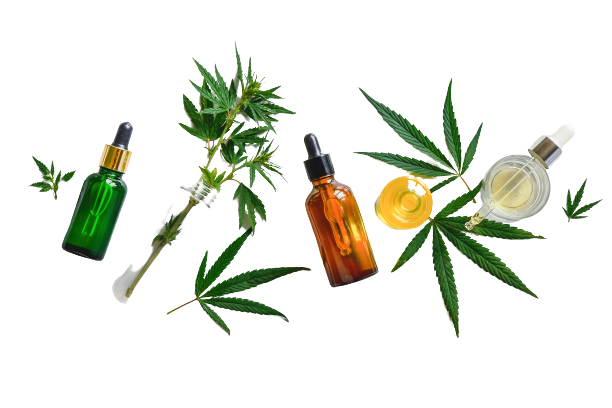
$109.00
Area 52
Area 52 Delta 8 THC Tinctures 30 mL
| Total Delta 8 THC: | 1200 mg |
| Delta 8 THC Potency: | 40 mg/mL |
| Cost per mg Delta 8 THC: | $0.09 |
| Delta 8 Source: | Hemp (<0.3% D9 THC) |

The best delta 8 THC tinctures for 2022 are here.
Check them out and learn how to use them effectively.
Delta 8 THC tinctures are described as the middle-ground between marijuana and CBD oils. They have the same relaxing and sedative action but with a psychoactive twist.
The active ingredient, delta 8 THC, is an analog of delta 9 THC — which is the primary psychoactive ingredient in marijuana.
As an analog, delta 8 THC has the same chemical formula as delta 9 but a slightly different shape. This difference gives delta 8 a unique set of effects. It’s more mellow and far less likely to lead to anxious side effects.
Here, we’ll cover everything you need to know about delta 8 THC tinctures — including the dose, what red flags to watch out for, and where to buy the best delta 8 tinctures this year (2021).
THC (tetrahydrocannabinol) is the active ingredient in marijuana. It’s the part of the plant that makes users feel high. Delta 8 is a type of THC described as being more relaxing, soothing, and sedative than other forms of THC.
Up until about 2017, there was only one version of THC people were talking about. But now we know there are several different types — each one with slight alterations in their effect profiles.
By far, the most abundant form of THC in the plant is delta 9 THC. The marijuana plant converts a cannabinoid called CBG (cannabigerol) into either CBD (cannabidiol), CBC (cannabichromene), or delta 9 THC.
Hemp plants mostly make CBD, while marijuana makes delta 9 THC instead.
As marijuana ages, some of it converts into delta 8 THC — the rest breaks down into CBN (cannabinol).
There are other forms of THC that aren’t found in nature, such as delta 2, 3, 6, 7, or 10. The most popular versions are delta 8 (relaxing and sedating), delta 9 (stimulating), delta 10 THC (cerebral or euphoric).

Delta 8 THC tinctures feel like a mix between CBD and THC. It’s psychoactive but only about half as strong as delta 9 THC products. Along with the characteristic psychoactive effects you’d expect from THC extracts, these tinctures are much more mellow or “chill.”
People that use them often describe the feeling as having more of a body load — which means the effects can be felt throughout the body, rather than purely in the mind.
Here are some common effects reported by users after taking delta 8 THC:
Because of how new delta 8 THC is to the market, there are very few studies available that explore its medical value.
With that said, recent studies have shown promising results on the use of delta 8 THC for managing pain and inflammation (topical) [1], nausea and vomiting [2], and low appetite [3].
There have never been any clinical trials that explore the use of delta 8 THC for managing anxiety or insomnia — but these are two of the most commonly reported benefits of this cannabinoid among frequent users.
We’ve been collecting data from our readers to quantify the effects of delta 8 THC and have found some interesting insights so far. Here are some of our findings on how people are using delta 8 THC out of 267 submissions (so far):

Have you tried delta 8 THC? Submit your experience with this 2-minute delta 8 THC survey.
The short answer is yes, delta 8 THC is legal in the US, but with some caveats.
There have never been any clear laws regulating delta 8 THC in any country. It’s only recently become popular, and laws haven’t had any time to adjust to the movement. Prior to 2017, delta 8 THC was virtually unknown. Nobody was selling delta 8, and nobody was looking for it.
The countries where delta 8 THC is illegal didn’t make these laws specifically for this cannabinoid. They’re laws that cover all forms of THC by default. Likewise, countries that specifically ban the delta 9 THC isomer only are much less clear.
Most legal experts agree that delta 8 THC is legal in the US and other countries that don’t specifically mention this cannabinoid. It’s found in nature, albeit in low concentrations.
Delta 8 THC is explicitly illegal in Australia, the United Kingdom, and most European countries. In Canada, delta 8 THC is legal — but not easy to find.
Learn more about the confusing legal status of delta 8 THC.
The dose of delta 8 THC is different for everybody. Your size, experience with delta 8 or other forms of THC, age, and individual metabolic factors can all affect the ideal dose of delta 8 THC.
To make matters more confusing, there are many different potencies of delta 8 tincture as well. Some tinctures contain 5 mg of delta 8 THC per milligram — others can deliver up to 50 mg of delta 8 THC per milligram.
While dosing sounds complicated, it doesn’t need to be; here are three steps to finding the perfect dose of delta 8 THC tincture:
The biggest factor that affects the best dose of delta 8 THC is your size. Using our chart below, you can find the approximate dosage range for delta 8 THC based on your weight. This number refers to the amount of pure delta 8 THC. From this number, you can determine how much oil you need to reach the desired dose regardless of how potent the oil is.
It’s best to start at the lowest dose first to see how it affects you before increasing the dose for future sessions.
| Your Weight | Starting Dose | Average Dose | Max Dose |
| 80–100 lbs (35 – 55 kg) | 5 mg | 10 mg | 20 mg |
| 120 – 140 lbs (55 – 65 kg) | 8 mg | 15mg | 30 mg |
| 140 – 160 lbs (65 – 72 kg) | 10 mg | 20 mg | 35 mg |
| 180 – 200 lbs (82 – 90 kg) | 12 mg | 30 mg | 45 mg |
| 220 – 240 lbs (100 – 110 kg) | 15 mg | 32 mg | 50 mg |
| >260 lbs (>120 kg) | 17 mg | 35 mg | 55 mg |
Delta 8 tinctures can come in many different strengths.
Most tinctures come in 30 mL (1 oz) bottles, but the total amount of delta 8 THC may be different from one manufacturer to the next. If you have 100 mg of delta 8 in one bottle and 500 in another, the amount of oil you need for the desired dose will be different for each.
The best way to assess the potency of a delta 8 tincture is to find the number of milligrams of delta 8 THC per milliliter of oil.
The dropper that comes with your tincture is designed to dispense 1 mL of oil for every full dropper. So if you know how much is in a dropper, it’s easy to measure specific doses very accurately.
To find this number divide the total delta 8 THC content in the bottle by the volume of the bottle.
Let’s do an example.
I’ve been testing the Area 52 tincture lately, which contains 1200 mg of delta 8 THC per bottle.
1200 / 30 = 40 mg/mL
If you want to really get accurate, you can further break this down into drop doses. Most droppers release about 30 drops for every mL of liquid. So you can divide the potency for each mL of oil by another 30 to find the dose per drop.
Using the example above, this bottle of delta 8 THC delivers roughly 1.3 mg per drop.
So now that we know the target dose of delta 8 based on our weight and the strength of our oil, it’s time to put them together.
The easiest way to explain this is with a few examples.
I weigh 160 lbs, which places me at a dose between 9 and 35 mg (ideally). If this was my first time using delta 8, I would take just 10 mg and wait to see how it feels for at least an hour before taking any more.
Using the Area 52 tincture, which we determined has a potency of 40 mg/mL, I would simply divide the ideal dose (10 mg) by the potency (40 mg) — which gives me 25%. So I essentially need to take a quarter of a dropper to get the perfect dose.
If I wanted to count it by the drop instead, I would divide the ideal dose (10 mg) by the potency per drop (1.3 mg), which gives me 7.7 (rounded up to 8). So I should take roughly 8 drops of oil to reach my desired dosage.

| Total Delta 8 THC: | 1200 mg |
| Delta 8 THC Potency: | 40 mg/mL |
| Cost per mg Delta 8 THC: | $0.09 |
| Delta 8 Source: | Hemp (<0.3% D9 THC) |
The cost of delta 8 THC tinctures can vary widely. This price is based on a few different factors, such as:
The best way to assess the price of delta 8 products is to look at the cost per mg. This allows you to distill the price to the active ingredient and makes it easy to compare products that have different bottle sizes and potencies.
This is the same advice we recommend when assessing the value of CBD tinctures.
You should expect to pay about $0.10 per mg of quality delta 8 THC extracts.
There are cheaper products out there that cost closer to $0.08 per mg, but these are almost always from low-quality companies that don’t provide third-party testing for their tinctures or have a track record of scammy or other unethical practices. It’s also more common to find contaminated products in this category.
The only exception to this is that some companies offer discounts for new buyers or other discounts if you sign up for monthly subscriptions or bulk order your tincture.
For example, some companies offer a monthly subscription that cuts up to 15% off the cost of each bottle — bringing the cost of their oil to $0.08 per mg.
Related: Read our do not buy list for delta 8 THC.
The premium category of delta 8 is usually over 10 cents per milligram — which places it on par with CBD tinctures. The premium space can be hard to navigate because it’s easier for a company to make low-quality products look expensive than it is for premium products to be cheap.
Making high-quality delta 8 THC requires a lot of skill and experience, which means hiring expensive chemists to perform the extraction and isomerization. It also requires a lot of testing (which can cost up to $800 per test) and some very sophisticated machinery.
The premium suppliers in the delta 8 THC space at the moment are Area 52, Finest Labs, and Delta Effex.
Some people are ordering delta 8 distillates to make their own tinctures at home. Buying delta 8 in bulk and making your own tinctures can save you a lot of money.
The process is simpler than you might expect, here’s a breakdown on how to do it yourself.
What you’ll need:
The first step is to decide how potent you want your tincture to be. This will determine the amount of distillate you’ll need to add to the bottle.
It’s a good idea to give your tincture a potency that has a nice round number for every milliliter of oil. This will make it easier to calculate doses later. For example, it’s easier to measure a 10 mg dose from a tincture that has either 5, 10, or 20 mg per mL than a tincture with 7 or 22 mg per mL.
The size of the bottle you’re using will make a difference here as well. The most common bottle sizes are 30 mL (1 oz) or 60 mL (2 oz).
We’ve broken down some measurements for you to help you decide how much distillate to use for your DIY tincture:
| Desired Potency | For 30 mL Bottles (1 oz) | For 60 mL Bottles (2 oz) |
| 5 mg/mL (Low-Potency) | 150 mg Δ8 Distillate | 300 mg Δ8 Distillate |
| 20 mg/mL (Medium Potency) | 600 mg Δ8 Distillate | 1,200 mg Δ8 Distillate |
| 40 mg/mL (High Potency) | 1,200 mg Δ8 Distillate | 2,400 mg Δ8 Distillate |
Once you’ve decided what potency you’d like to make your tincture, you just need to measure the distillate.
If your distillate arrived in a syringe with numbered markings on the side, this step is super simple.
You can use the markings to squeeze the distillate directly into your empty tincture bottle directly. One marking indicated 0.1 mL on most tinctures. Every 0.1 mL works out to around 10 mg of Δ8 THC.
The weight to volume of Δ8 distillate is very similar (1.00:1.02) — so you can also measure your delta 8 using a small scale if your distillate didn’t come in a numbered syringe. For this, you just measure the dose directly. So 150 mg of distillate works out to 150 mg of delta 8 directly.
Add the distillate directly to the empty tincture bottle.
Once the distillate is sitting in the bottom of the bottle, you can add the carrier oil on top. Fill it up to the fill line, which is just below the neck of the bottle.
Don’t fill the oil to be flush with the top of the bottle. When you add the dropper into the tincture, it’s going to displace the oil and cause it to overflow.
Once you’ve added the carrier oil, seal it up and shake vigorously to allow the distillate to diffuse into the oil.
This step can take a while, so you’ll need to keep shaking. If the distillate isn’t dissolving, it helps to gently heat the oil by setting it into some warm water. Keep shaking until you can’t see any more distillate at the bottom of the bottle.
Make sure to label your bottle when you’re done. Include the total amount of distillate you used, the date the tincture was made, and leave a note that it’s psychoactive, so nobody mistakes it for another supplement (such as CBD oil).

Delta 8 is new to the market, but it’s likely here to stay. The main reason people use this cannabinoid at the moment is because it’s a legal alternative to conventional THC.
However, there’s a lot to this cannabinoid that makes it valuable in other ways too.
Delta 8 THC is far less likely to cause anxiety — which is one of the main side effects users report from THC products. It’s also a better sedative, muscle-relaxant, and formidable anti-nausea agent.
The introduction of delta 8 marks a monumental moment in cannabinoid development. Now, users can truly customize the products they’re using to get the exact set of effects they’re looking for.
We expect to see delta 8, delta 10, and other THC-isomer tinctures become commonplace in the cannabis industry moving forward.